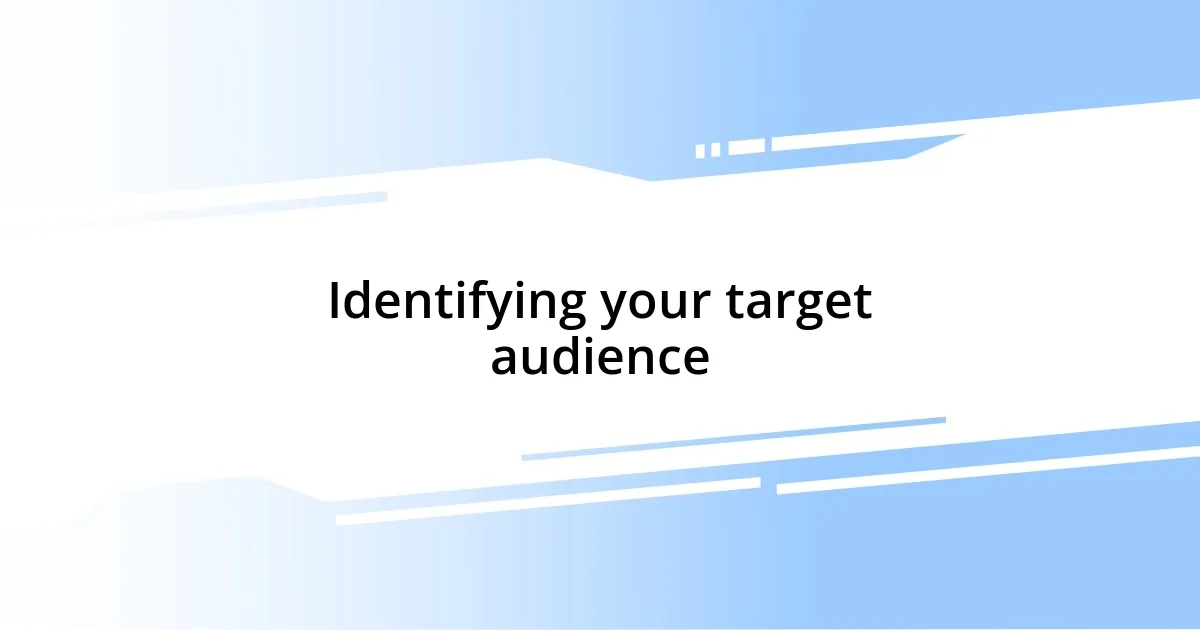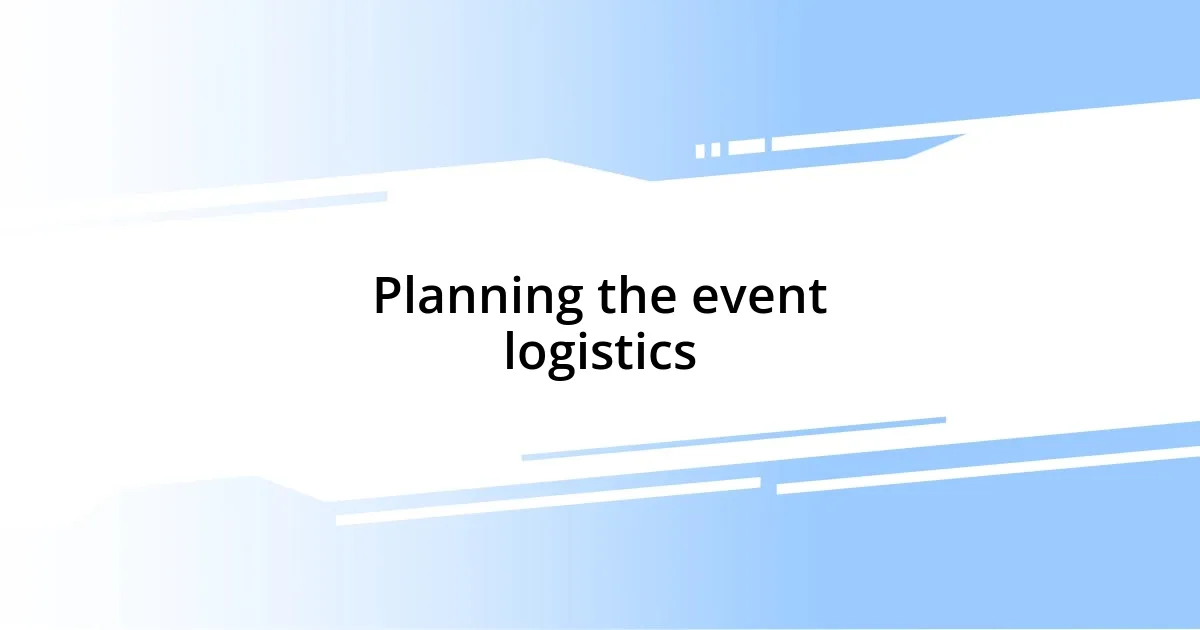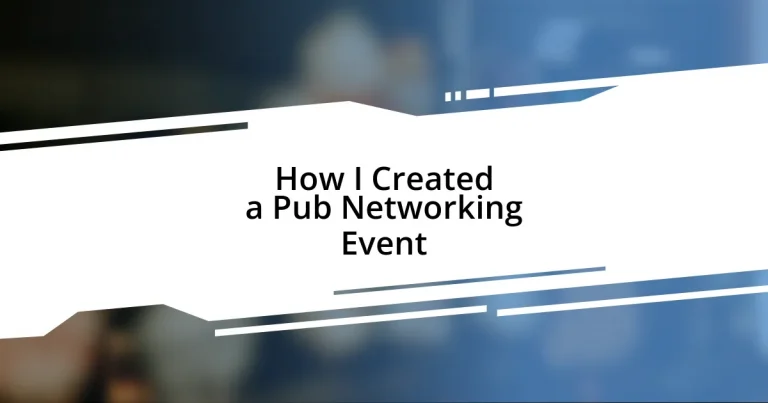Key takeaways:
- Identify and define your target audience to create quality connections and tailor the event to their interests.
- Select a venue that fosters a conducive atmosphere, is easily accessible, and has the right capacity for attendees.
- Engage attendees through interactive activities and follow up with personalized gratitude and feedback to build a lasting community.
- Analyze post-event feedback to understand attendee preferences and improve future networking gatherings.

Identifying your target audience
To really hit the mark with your networking event, you need to define who you want to attract. Think about what professions or interests would align with the goals of your event. Personally, I once aimed specifically at local entrepreneurs. They bring energy, ideas, and a desire to connect, making the atmosphere more vibrant.
Consider the demographics that appeal to your desired audience. Are they young professionals seeking mentorship or seasoned experts willing to share their insights? I remember feeling quite overwhelmed when I tried to cater to everyone. That experience taught me the importance of honing in on specific groups. It wasn’t just about quantity; it was about quality connections.
Engage with your potential audience before the event. Use social media or surveys to gather insights on what they value in networking. When I asked for input from my contacts, it felt rewarding to tailor my event according to their preferences. It not only enhanced my understanding but also built anticipation for the event itself. Isn’t it exciting to create something that resonates with others?

Choosing the right venue
Choosing the right venue is one of the most crucial aspects of planning a successful pub networking event. From my experience, the atmosphere can significantly influence the interactions among attendees. For instance, I once selected a bustling pub characterized by its lively decor and open space. It fostered a sense of community, encouraging attendees to mingle more freely.
Location is equally important. Think about how accessible the venue is for your target audience. I recall organizing my first event in a pub that was somewhat tucked away. While the ambiance was great, many people mentioned they had trouble finding it. This taught me to prioritize venues that are not just appealing but also strategically placed, ensuring easy access for all potential attendees.
Another essential consideration is the capacity of the venue. You want to avoid overcrowding but also ensure there’s enough space to accommodate everyone comfortably. I’ve seen events where the venue was too small, leading to a cramped atmosphere that stifled conversation. After that experience, I always factor in both the expected turnout and the layout that promotes engagement when selecting a venue.
| Criteria | Examples |
|---|---|
| Atmosphere | Vibrant, informal settings encourage networking (e.g., colorful decor, music) |
| Accessibility | Easy public transport access, ample parking nearby |
| Capacity | Space for mingling without overcrowding (e.g., private rooms, outdoor areas) |

Planning the event logistics
Planning the logistics of a pub networking event requires attention to detail and a proactive mindset. I learned firsthand that laying out a clear timeline is essential for keeping everything on track. I remember feeling the pressure as the date approached, which made me realize the importance of managing tasks like confirmations, supplies, and communications well in advance. This foresight alleviated a lot of last-minute stress, allowing me to focus on making the event enjoyable.
Here’s a quick checklist to guide your planning:
- Timeline: Set deadlines for venue booking, guest invitations, and supply orders.
- Budget: Outline your total budget and allocate funds for venue, food, drinks, and any promotional materials.
- Supplies: List any necessities like name tags, seating arrangements, and handouts for participants.
- Staffing: Decide if you need volunteers or paid staff for setup, registration, and event management.
- Promotion: Plan a strategy for promoting the event—social media, email invitations, or community boards.
One thing I wish I had done earlier was using digital tools to streamline the organization process. The software I used not only helped me track RSVPs but also allowed me to communicate with attendees effortlessly. It was satisfying to see everything come together smoothly because I anticipated potential hitches ahead of time.

Promoting the networking event
Once the venue was secured, I jumped into promoting the networking event, which was an adventure in itself. I remember sitting at my kitchen table, brainstorming ways to spread the word. Social media became my best friend. Platforms like Instagram and LinkedIn allowed me to create buzz by sharing eye-catching graphics and compelling messages. Have you ever noticed how a well-timed post can create a ripple effect? It was thrilling to see my network engage and share the event with their connections.
I also tapped into local community boards and networking groups. One memorable experience involved crafting a humorous flyer that listed unexpected benefits of attending, like “Find your new best friend or your next business partner!” The fun tone generated replies from several participants about their excitement. It’s like magic when you evoke a positive emotional response in potential attendees; it reassures them that this event is worth their time.
Another crucial element was sending personalized invitations. I took extra time to reach out directly to people I thought would greatly benefit from the event. I’ll never forget the relief I felt when one of my mentors replied with enthusiasm, saying, “I wouldn’t miss it for the world!” That reassurance confirmed I was on the right track. Providing a personal touch not only made attendees feel valued but also encouraged them to bring along their own networks, amplifying the reach of my event. Who doesn’t appreciate a warm invitation that feels tailor-made just for them?

Engaging attendees during the event
To keep attendees engaged during the event, I found that structuring activities around icebreakers was vital. I remember feeling a sense of relief when I introduced a fun game that encouraged mingling, like “Two Truths and a Lie.” It’s amazing how a little humor and creativity can break down barriers and get people chatting. Have you ever seen how laughter can ignite a room? The atmosphere shifted instantly, and conversations flowed more freely.
As the event progressed, I made sure to incorporate interactive discussions rather than traditional presentations. One of the most rewarding moments came when I invited everyone to share their biggest professional wins. The enthusiasm in the room was palpable as stories bubbled up; I could sense that a deeper connection was forming. This kind of involvement turned what could have been a monotonous experience into a vibrant exchange of ideas. How incredible is it that everyone has unique perspectives to offer?
Finally, I discovered the power of follow-up during the event itself. I set up a digital feedback station where attendees could share their thoughts on the go. This not only made people feel heard but also fostered a sense of investment in the event. I vividly recall one attendee expressing his surprise at how engaged he felt, leading to a conversation that continued long after the event concluded. It’s a tremendous feeling to create a space where everyone feels they belong and can contribute. How do you think that sense of belonging shapes future interactions?

Following up after the event
Following up after the event is just as crucial as the event itself. I recall diving into my email the very next day, eager to express my gratitude to attendees. There’s something special about sending a heartfelt thank-you, especially when it’s tailored to each person’s contribution or experience. For instance, I remembered a participant who shared a particularly insightful story about pivoting careers; I made it a point to mention this in my note. It’s a small touch, but it reaffirms their importance in the community.
A few days later, I sent out a survey to gather feedback. I was pleasantly surprised by the constructive insights I received. I had genuinely worried that people might skate over it, but many took the time to share their thoughts. One attendee even wrote about how the event inspired them to approach their work with renewed passion—can you imagine how fulfilling that is to hear? This feedback loop not only enhances future events but also fosters a sense of collaboration and growth among attendees.
Additionally, I made it a priority to connect people who met at the event through follow-up emails. I remember introducing two attendees who both mentioned their interest in the same industry. A week later, they reached out to tell me how they had started collaborating on a project! Connecting others feels like planting seeds for future networking success; isn’t it amazing when you can be a small part of someone’s journey? Following up is about building a lasting community, and these interactions amplify that feeling of togetherness.

Evaluating event success and feedback
Evaluating the success of an event can feel daunting, but I believe the real magic lies in the feedback we gather. After receiving responses from my post-event survey, I was struck by the diverse perspectives attendees shared. One comment particularly resonated with me—it highlighted how a simple conversation about career challenges led to collaborative ideas. Isn’t it fascinating how impactful a single connection can be?
As I delved deeper into the feedback, I noticed patterns that revealed what truly excited attendees. For instance, many appreciated the interactive discussions and wanted more of that in future events. This reinforced my belief that creating an engaging environment isn’t just nice to have; it’s essential for success. Reflecting on these insights helps me understand the evolving needs of the community, prompting the question: how can we keep adapting to serve our audience better?
I’ll never forget the nervous anticipation I felt while reviewing the feedback in real-time. Seeing positive comments flash across my screen made my heart race with excitement. It was like receiving small tokens of validation for the hard work leading up to the event. However, hearing critical feedback was just as valuable; it showed me areas where I could grow and improve. It made me wonder, how can we embrace constructive criticism to enhance our future gatherings? Engaging with feedback opens a door to continuous improvement, ensuring that every event is even better than the last.














